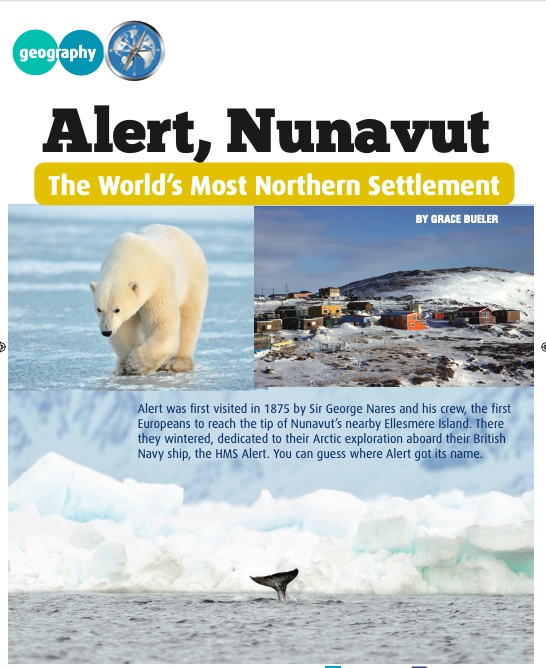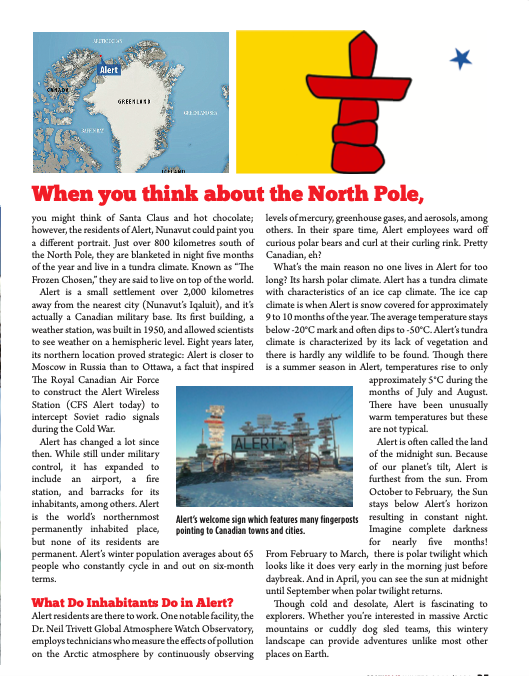

Alert was first visited in 1875 by Sir George Nares and his crew, the first Europeans to reach the tip of Nunavut’s nearby Ellesmere Island. There they wintered, dedicated to their Arctic exploration aboard their British Navy ship, the HMS Alert. You can guess where Alert got its name.
When you think about the North Pole,
you might think of Santa Claus and hot chocolate; however, the residents of Alert, Nunavut could paint you a different portrait. Just over 800 kilometres south of the North Pole, they are blanketed in night five months of the year and live in a tundra climate. Known as “The Frozen Chosen,” they are said to live on top of the world.
Alert is a small settlement over 2,000 kilometres away from the nearest city (Nunavut’s Iqaluit), and it’s actually a Canadian military base. Its first building, a weather station, was built in 1950, and allowed scientists to see weather on a hemispheric level. Eight years later, its northern location proved strategic: Alert is closer to Moscow in Russia than to Ottawa, a fact that inspired The Royal Canadian Air Force to construct the Alert Wireless Station (CFS Alert today) to intercept Soviet radio signals during the Cold War.
Alert has changed a lot since then. While still under military control, it has expanded to include an airport, a fire station, and barracks for its inhabitants, among others. Alert is the world’s northernmost permanently inhabited place, but none of its residents are permanent. Alert’s winter population averages about 65 people who constantly cycle in and out on six-month terms.
What Do Inhabitants Do in Alert?
Alert residents are there to work. One notable facility, the Dr. Neil Trivett Global Atmosphere Watch Observatory, employs technicians who measure the effects of pollution on the Arctic atmosphere by continuously observing levels of mercury, greenhouse gases, and aerosols, among others. In their spare time, Alert employees ward off curious polar bears and curl at their curling rink. Pretty Canadian, eh?
What’s the main reason no one lives in Alert for too long? Its harsh polar climate. Alert has a tundra climate with characteristics of an ice cap climate. The ice cap climate is when Alert is snow covered for approximately 9 to 10 months of the year. The average temperature stays below -20°C mark and often dips to -50°C. Alert’s tundra climate is characterized by its lack of vegetation and there is hardly any wildlife to be found. Though there is a summer season in Alert, temperatures rise to only approximately 5°C during the months of July and August. There have been unusually warm temperatures but these are not typical.
Alert is often called the land of the midnight sun. Because of our planet’s tilt, Alert is furthest from the sun. From October to February, the Sun stays below Alert’s horizon resulting in constant night. Imagine complete darkness for nearly five months!
From February to March, there is polar twilight which looks like it does very early in the morning just before daybreak. And in April, you can see the sun at midnight until September when polar twilight returns.
Though cold and desolate, Alert is fascinating to explorers. Whether you’re interested in massive Arctic mountains or cuddly dog sled teams, this wintery landscape can provide adventures unlike most other places on Earth.

